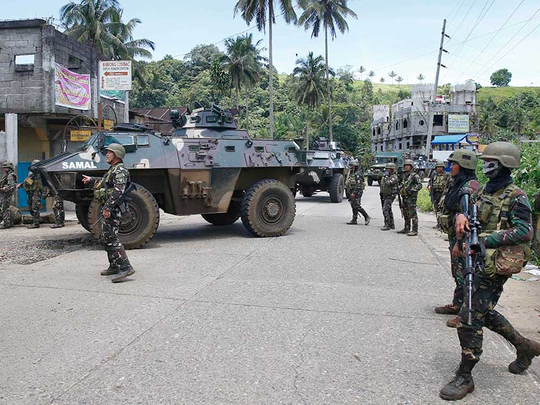
Manila: The US military can conduct air strikes against terrorist positions in Marawi City if the Pentagon and President Rodrigo Duterte approve such actions, Philippine officials said on Tuesday.
“There must be a covenant between the commanders-in-chief of both nations before that option may be adopted,” Gen. Eduardo Año, chief of the Armed Forces of the Philippines (AFP), said.
He was responding to media reports that the Pentagon was mulling the possibility of carrying out air strikes against the Daesh-inspired Maute-Abu Sayyaf militants in Marawi City.
The air strike plan, according to a report by the US-based NBC News on Monday, would be justified as part of a “collective self-defence” and would likely be carried out by armed drones of the United States instead of manned attack/fighter aircraft.
The fighting in Marawi City had dragged on for more than three weeks with deaths from the conflict reaching a total 740 as of August 6.
The Philippine army reported that, 582 of those killed were from the Maute-Abu Sayyaf, while 122 were from government force. Civilians accounted for another 45 fatalities.
Fighting broke out in Marawi City, in Central Mindanao, on May 23 when government troops arrested leaders of the Maute as well as their Western Mindanao-based ally, Isnilon Hapilon, leader of the Abu Sayyaf in Basilan.
But bringing in the aerial might of the US to bear on the terror threat may not be that easy.
Under the rules of the Philippines’ Mutual Defence Treaty with the US, either countries can come to the aid of the other only in the event of an armed invasion. This was reiterated by Defence Secretary Delfin Lorenzana who said that at least on his level (Defence Secretary), “there are no discussions (yet) regarding air strikes.”
“The DND (Department of National Defence) denies any discussions regarding the use of US drones to strike against Daesh-inspired terrorist groups in the Philippines. The AFP also states that no such discussions have occurred at their level,” said Lorenzana.
“Direct military actions are only allowed during actual foreign invasion by another state actor. Hence, such a proposition has to undergo a process and an agreement must be reached that should have the approval of both the highest officials of our nations,” he said.
Although US-made materiel comprise most of the ordinance used in the Philippines’ fight against the Maute-Abu Sayyaf, these fall short on seriously eroding the capability of the terrorists who are fighting from heavily fortified bunkers, some of which, reports said, are located underground.
While the Philippine Air Force (PAF) FA-50 are capable of delivering bunker-busting missiles such as the Hellfire, however the this particular weapon is not in the inventory of the PAF.
The US has Predator drones that could carry bunker as well as tank-busting Hellfire or other missiles with similar capabilities.
Lorenzana said that while Philippine-US security relations and counter terrorism efforts are robust, US assistance has been limited to technical assistance, sharing of information and training.
“Terrorism has indeed become a global menace that the community of nations must unite against,” he said, adding that ASEAN, the regional bloc, has issued strong statements on the matter.











